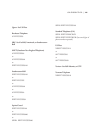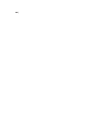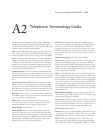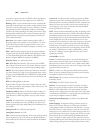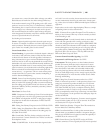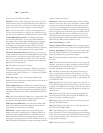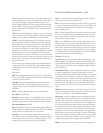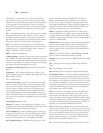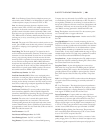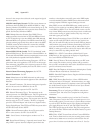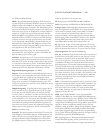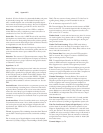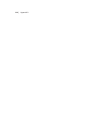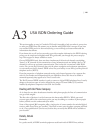GUIDE TO TELEPHONE TERMINOLOGY | 109
Company then any call outside of your LATA or any Interstate call
is considered long distance and is handled by an IEC. e above is
true regardless of whether you are referring to a dedicated line or a
dial up call. 2) However, under the current state of deregulation, toll
calls within a LATA may now be covered by the IEC, and in some
cases RBOCs are being permitted to handle InterLATA calls.
Loop- e telephone circuit from the CO to the customers prem-
ises. Generally refers to a copper cable circuit.
Loop Current Disconnect Supervision - Another name for CPC.
See CPC
Loop Qualification- Process of actually measuring the loss on a
prospective ISDN line to see if it can be used for ISDN service. e
actual loss on the line (usually measured at 40 kHz) is the determin-
ing factor whether ISDN service can be offered without a repeater.
Generally ISDN is available up to 18,000 feet from the serving
Central Office. It may not be available within this range, or may be
available further from the CO. Only a loop qualification can tell for
sure. Not all Telcos will extend ISDN lines with repeaters.
Loop Start Line - A plain old telephone line. e telephone termi-
nal signals the “off hook” condition by allowing DC current to flow.
See Ground Start Trunk. See also Glare.
Loop Start Trunk – A plain old telephone line connected to a
PBX switch. See Loop Start Line. e PBX signals the “off hook”
condition by allowing DC current to flow. Ground Start Trunks are
generally preferred for use on PBXs to prevent glare. See Ground
Start Trunk. See also Glare. e Telco may call this a “Loop Start
Line”.
LOS- Loss Of Signal. An LED or other indicator that illuminates
if a signal is absent. is terminology is commonly used with T-1
equipment.
LT - Line Termination - e electrical and protocol specifications
for the Central Office end of an ISDN line. If you wish to connect
an ISDN terminal (such as a Zephyr Xstream) to a PBX the PBX
must support LT ISDN. See also NT and Line Card
Lucent Technologies- Company which now makes the former
AT&T 5ESS switch, as well as various other piece of Telco gear and
semiconductors. Lucent was split off from AT&T in 1996. As of
approximately 1999 Lucent sold their telephone set manufacturing
business (and the right to use the AT&T name on telephone sets)
to V-Tech. V-Tech is using the AT&T name and line as their high-
end line. Lucent’s PBX division was spun off in 2001 as AVAYA.
MCLD- Modifying Calling Line Disconnect. e parameter on
the Lucent 5ESS switch that determines if CPC is active. Should
be set to “Yes” if CPC is required. See CPC
MOS Grade- “Mean Opinion Score” Grade is a measure of codec
quality, ranging from 1 to 5. ese are derived from subjective tests
with listening panels comprised of both experts and “people from
LEC- Local Exchange Carrier. Your local telephone service pro-
vider which is either an RBOC or an Independent. In other words,
a traditional phone company. In contrast to CLEC or IEC.
Line- An electrical connection between a telephone service
provider’s switch (LEC or CLEC) and a telephone terminal or
Key system. An electrical connection between a telephone service
provider’s switch and another switch is technically called a trunk.
Note that some type of physical lines offer more than one channel.
I.E. a BRI circuit has 2 channels, called B channels. is term is a
confusing one, so we try to avoid using it. See Channel. See also
Station Line.
Line card- e circuit in the Telco switch to which your line is con-
nected. On an ISDN circuit the line card performs a role analogous
to the NT1 in adapting to and equalizing the circuit to establish
OSI Layer 1.
Line Coding, T1- e clock signal for T1 is derived at the far
end from the data bits themselves. erefore, T1 lines have certain
restrictions as to the data allowed. No more than 15 zeros shall be
sent in a row; and average density of 12.5% ones must be main-
tained. e CSU is responsible to ensure that these requirements
are met. e line encoding method, AMI or B8ZS determines
exactly how these requirements are met while still allowing recovery
of the original data at the far end. Your Telco will determine the
method used on a specific circuit. B8ZS is preferred. E1 circuits
have similar restrictions. HDB3 is preferred for E1 circuits.
Listed Directory Number- See LDN
Line Echo Canceller (LEC)- When a two-way digital path is
interfaced to an analog line, echoes result from the leakage of the
send audio into the receive. When combined with delay, these are
annoying and can disrupt conversation. An LEC works to remove
these echoes, usually using an adaptive digital filter. See Hybrid.
Line Encoding, T1- See Line Coding, T1.
Line Format, T1-Modern T1 circuits usually use either Super-
frame (sometimes called SF or D4) or Extended Superframe
(sometimes called ESF) line formatting. e type of framing used is
determined by your Telco. ESF is preferred. See ESF and SF
Line Side- is is the side of a central office switch that the
subscriber’s telephone lines are connected to. e main reason
for distinguishing between this and the trunk side is that certain
customer related features (Such as CLASS and Centrex features)
are inapplicable to trunks. See also Trunk Side. 2) e user side of a
PBX. Also called the station side.
Line Termination - See LT.
Local Access and Transport Area- See LATA.
Local Exchange Carrier- See LEC and CLEC.
Long Distance- If your local Telco is a former Bell Operating



